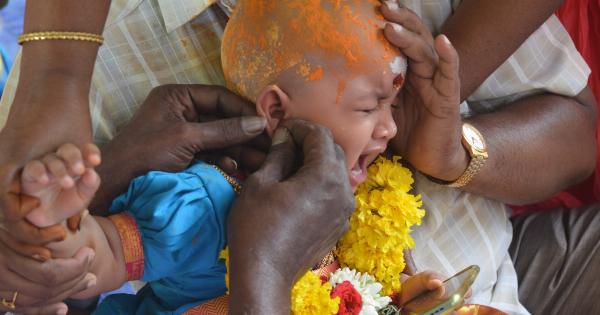Piercing a baby’s ears has been a common cultural practice in many parts of the world. It is often seen as a way to enhance the aesthetic appeal of a baby girl.
However, there are various health risks associated with this practice that parents should be aware of before making a decision. This article discusses the potential health risks of piercing a baby’s ears and provides information to help parents make an informed choice.
1. Infection
One of the main health risks associated with piercing a baby’s ears is the risk of infection. Babies have delicate and sensitive skin, and any type of invasive procedure can increase the chances of introducing harmful bacteria into the body.
Even with proper sterilization of instruments and good hygiene practices, there is still a risk of infection.
2. Allergic Reactions
Another health risk is the possibility of allergic reactions. Some babies may have an allergic reaction to the metals used in earrings, such as nickel or gold. This can result in redness, itching, swelling, and even skin irritation.
Identifying the specific metal that causes an allergic reaction can be challenging in babies, leading to prolonged discomfort.
3. Pain and Discomfort
Piercing a baby’s ears can cause pain and discomfort. Babies have a lower pain threshold compared to older children and adults.
The procedure itself may cause distress and anxiety for the baby, and the pain may persist for some time after the piercing is done. This can affect the baby’s overall mood and well-being.
4. Hypersensitivity
Some babies may develop hypersensitivity around the pierced area. This can make it difficult for them to wear earrings comfortably and may lead to an aversion to any kind of jewelry in the future.
Continuous irritation and hypersensitivity can hinder the healing process and increase the chances of complications.
5. Keloids
Keloids are raised scars that form at the site of a wound or injury. Babies with a genetic predisposition to keloid formation may develop keloids around the pierced area. Keloids can be itchy, painful, and aesthetically unpleasing.
They may require additional medical intervention to manage and prevent further complications.
6. Risk of Injury
Babies are active and curious, and their earrings can increase the risk of injury. The earrings may get caught on clothing, toys, or furniture, resulting in tears or cuts to the earlobes.
This can be particularly dangerous if the earring gets forcefully pulled, leading to torn or stretched earlobes that may require surgical repair.
7. Difficulty in Cleaning and Maintenance
Baby earrings require regular cleaning to prevent infection and promote healing. However, babies are often unable to cooperate during the cleaning process, making it challenging for parents to maintain proper hygiene around the pierced area.
This can increase the risk of bacterial colonization and subsequent infection.
8. Delayed Development
Piercing a baby’s ears involves creating small wounds that need time to heal. The healing process can interfere with the natural development of the earlobes, potentially leading to asymmetrical or distorted earlobes.
In severe cases, complications from the piercing may require surgical correction, causing additional stress and discomfort for the baby.
9. Emotional and Psychological Impact
Some babies may experience distress or anxiety due to the discomfort associated with pierced ears. They may find it challenging to adjust to the new sensation and appearance.
This can affect their emotional well-being and may result in prolonged irritability or changes in behavior.
10. Cultural and Personal Autonomy
It is important to consider the baby’s own cultural and personal autonomy when making a decision about piercing their ears.
Babies should have the opportunity to make decisions about their own bodies when they are old enough to understand the implications. Piercing a baby’s ears without their consent may disregard their future preferences and desires.
Conclusion
Piercing a baby’s ears may seem like a harmless practice, but it comes with several health risks that should not be taken lightly.
From the risk of infection and allergic reactions to pain, discomfort, and delayed development, parents need to carefully weigh the potential consequences. It is essential to prioritize the well-being and autonomy of the baby when making decisions about body modification.
Consulting with pediatricians and considering alternative ways to celebrate cultural traditions can help parents make an informed choice.






























